Detailed Analysis of PC World's Supply Chain Management Strategies
VerifiedAdded on 2020/02/05
|8
|1679
|38
Report
AI Summary
This report provides a comprehensive analysis of PC World's supply chain management, contrasting its online and offline distribution models. It begins with an introduction to supply chain management and then explores the specific strategies employed by PC World in both its online and offline retail environments. The report details the online supply chain, outlining the steps from order placement to delivery, and illustrates this with a diagram. The offline model is also examined, breaking down the stages from purchasing laptops to distributing them through various zones and retailers. A key focus is the comparison of the two models, highlighting differences in technology usage, customer persuasion, data generation, and overall supply chain structure. The report concludes by emphasizing the importance of balancing both online and offline strategies to maximize revenue and meet customer needs effectively. The report uses various sources to support its findings.

E-BUSINESS
Paraphrase This Document
Need a fresh take? Get an instant paraphrase of this document with our AI Paraphraser
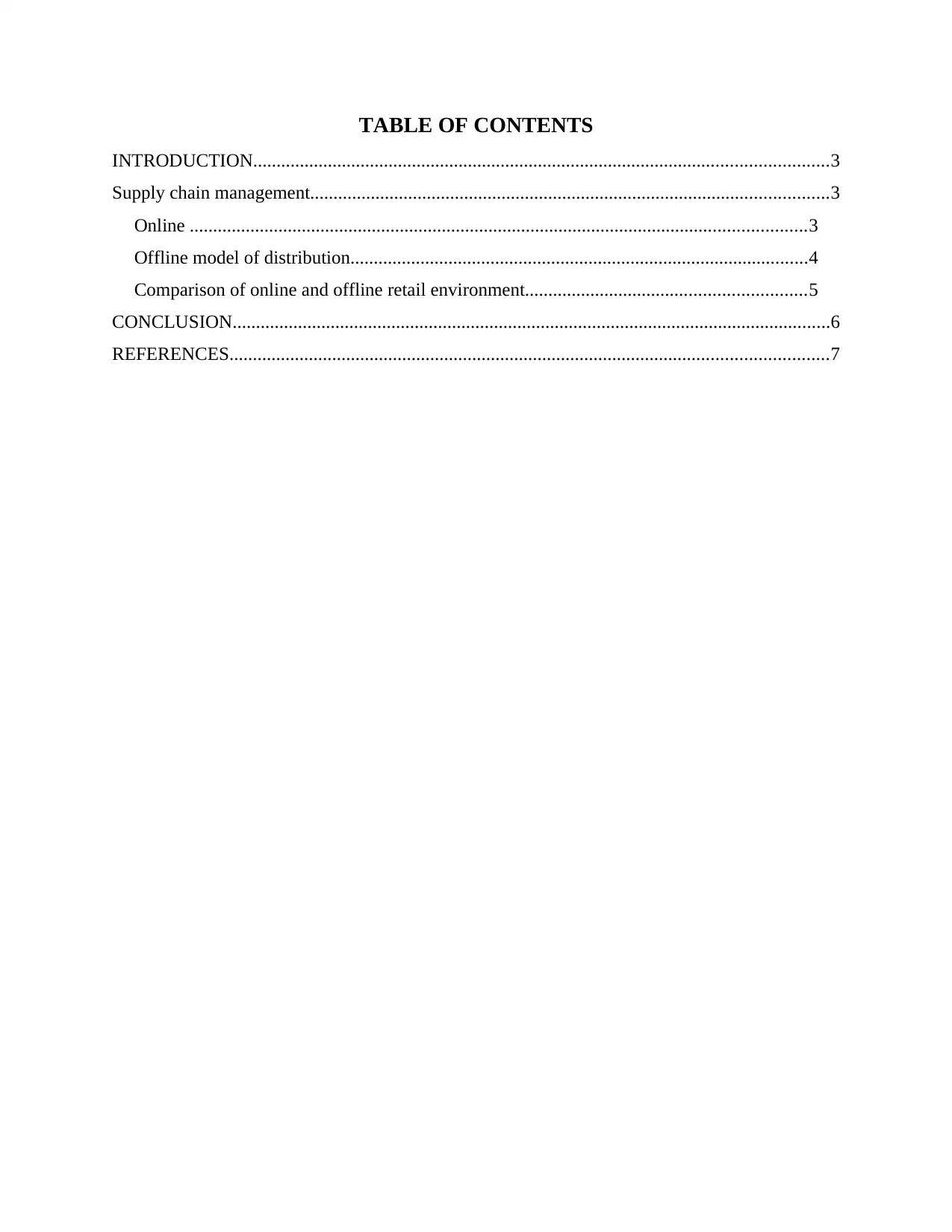
TABLE OF CONTENTS
INTRODUCTION...........................................................................................................................3
Supply chain management...............................................................................................................3
Online ....................................................................................................................................3
Offline model of distribution..................................................................................................4
Comparison of online and offline retail environment............................................................5
CONCLUSION................................................................................................................................6
REFERENCES................................................................................................................................7
INTRODUCTION...........................................................................................................................3
Supply chain management...............................................................................................................3
Online ....................................................................................................................................3
Offline model of distribution..................................................................................................4
Comparison of online and offline retail environment............................................................5
CONCLUSION................................................................................................................................6
REFERENCES................................................................................................................................7

ILLUSTRATION INDEX
Illustration 1: Online supply chain management model of PC world..............................................3
Illustration 2: Offline supply chain model of PC world..................................................................4
Illustration 1: Online supply chain management model of PC world..............................................3
Illustration 2: Offline supply chain model of PC world..................................................................4
⊘ This is a preview!⊘
Do you want full access?
Subscribe today to unlock all pages.

Trusted by 1+ million students worldwide
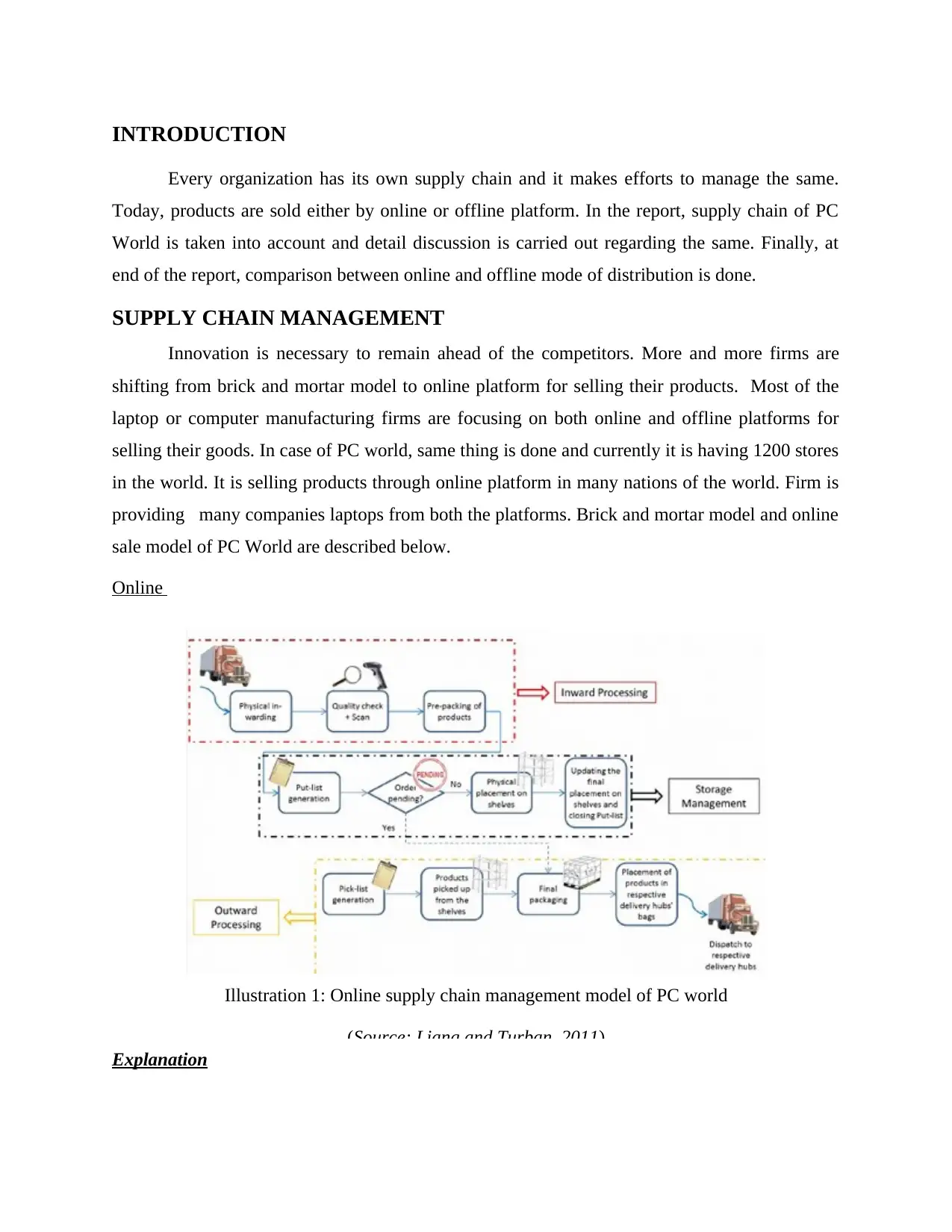
INTRODUCTION
Every organization has its own supply chain and it makes efforts to manage the same.
Today, products are sold either by online or offline platform. In the report, supply chain of PC
World is taken into account and detail discussion is carried out regarding the same. Finally, at
end of the report, comparison between online and offline mode of distribution is done.
SUPPLY CHAIN MANAGEMENT
Innovation is necessary to remain ahead of the competitors. More and more firms are
shifting from brick and mortar model to online platform for selling their products. Most of the
laptop or computer manufacturing firms are focusing on both online and offline platforms for
selling their goods. In case of PC world, same thing is done and currently it is having 1200 stores
in the world. It is selling products through online platform in many nations of the world. Firm is
providing many companies laptops from both the platforms. Brick and mortar model and online
sale model of PC World are described below.
Online
Explanation
Illustration 1: Online supply chain management model of PC world
(Source: Liang and Turban, 2011)
Every organization has its own supply chain and it makes efforts to manage the same.
Today, products are sold either by online or offline platform. In the report, supply chain of PC
World is taken into account and detail discussion is carried out regarding the same. Finally, at
end of the report, comparison between online and offline mode of distribution is done.
SUPPLY CHAIN MANAGEMENT
Innovation is necessary to remain ahead of the competitors. More and more firms are
shifting from brick and mortar model to online platform for selling their products. Most of the
laptop or computer manufacturing firms are focusing on both online and offline platforms for
selling their goods. In case of PC world, same thing is done and currently it is having 1200 stores
in the world. It is selling products through online platform in many nations of the world. Firm is
providing many companies laptops from both the platforms. Brick and mortar model and online
sale model of PC World are described below.
Online
Explanation
Illustration 1: Online supply chain management model of PC world
(Source: Liang and Turban, 2011)
Paraphrase This Document
Need a fresh take? Get an instant paraphrase of this document with our AI Paraphraser
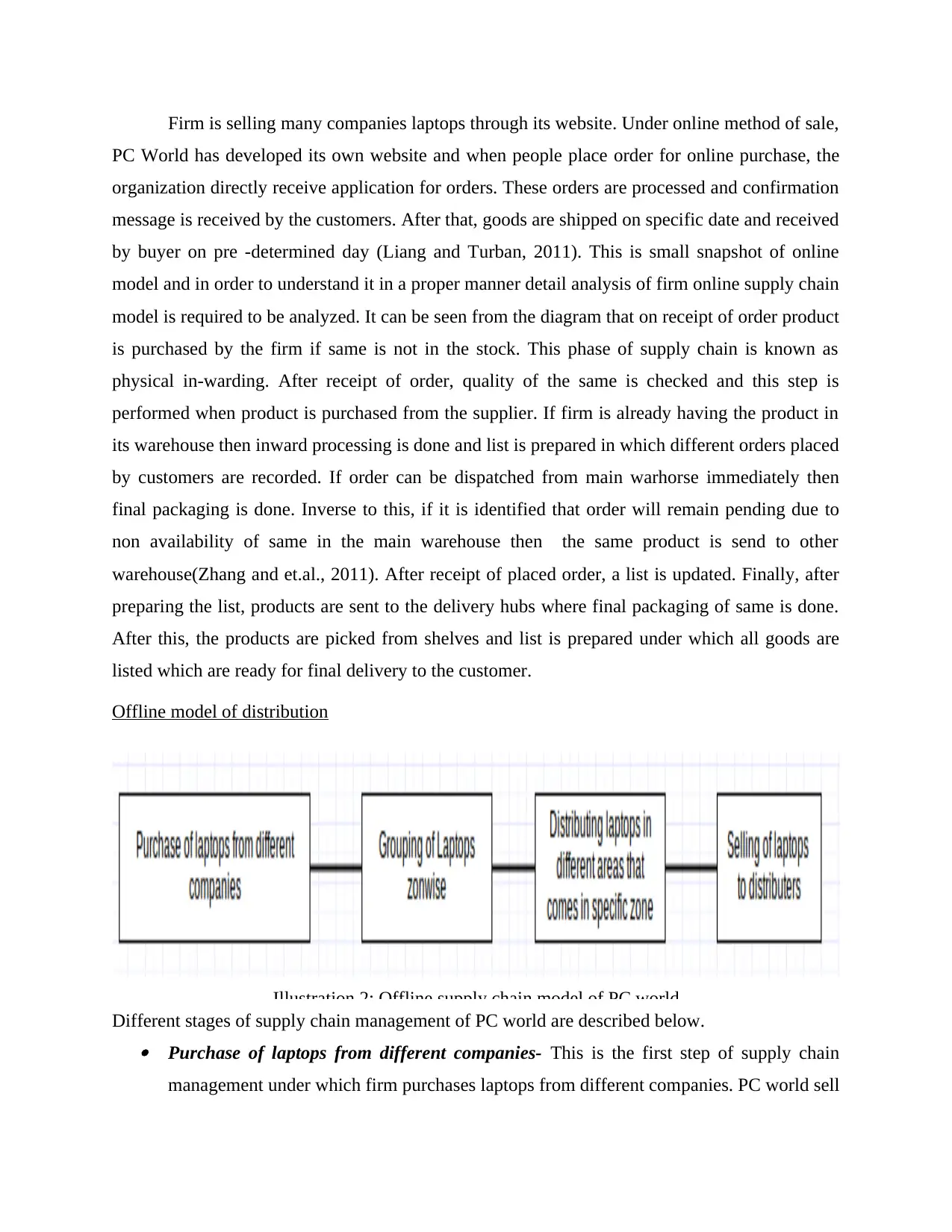
Firm is selling many companies laptops through its website. Under online method of sale,
PC World has developed its own website and when people place order for online purchase, the
organization directly receive application for orders. These orders are processed and confirmation
message is received by the customers. After that, goods are shipped on specific date and received
by buyer on pre -determined day (Liang and Turban, 2011). This is small snapshot of online
model and in order to understand it in a proper manner detail analysis of firm online supply chain
model is required to be analyzed. It can be seen from the diagram that on receipt of order product
is purchased by the firm if same is not in the stock. This phase of supply chain is known as
physical in-warding. After receipt of order, quality of the same is checked and this step is
performed when product is purchased from the supplier. If firm is already having the product in
its warehouse then inward processing is done and list is prepared in which different orders placed
by customers are recorded. If order can be dispatched from main warhorse immediately then
final packaging is done. Inverse to this, if it is identified that order will remain pending due to
non availability of same in the main warehouse then the same product is send to other
warehouse(Zhang and et.al., 2011). After receipt of placed order, a list is updated. Finally, after
preparing the list, products are sent to the delivery hubs where final packaging of same is done.
After this, the products are picked from shelves and list is prepared under which all goods are
listed which are ready for final delivery to the customer.
Offline model of distribution
Different stages of supply chain management of PC world are described below. Purchase of laptops from different companies- This is the first step of supply chain
management under which firm purchases laptops from different companies. PC world sell
Illustration 2: Offline supply chain model of PC world
PC World has developed its own website and when people place order for online purchase, the
organization directly receive application for orders. These orders are processed and confirmation
message is received by the customers. After that, goods are shipped on specific date and received
by buyer on pre -determined day (Liang and Turban, 2011). This is small snapshot of online
model and in order to understand it in a proper manner detail analysis of firm online supply chain
model is required to be analyzed. It can be seen from the diagram that on receipt of order product
is purchased by the firm if same is not in the stock. This phase of supply chain is known as
physical in-warding. After receipt of order, quality of the same is checked and this step is
performed when product is purchased from the supplier. If firm is already having the product in
its warehouse then inward processing is done and list is prepared in which different orders placed
by customers are recorded. If order can be dispatched from main warhorse immediately then
final packaging is done. Inverse to this, if it is identified that order will remain pending due to
non availability of same in the main warehouse then the same product is send to other
warehouse(Zhang and et.al., 2011). After receipt of placed order, a list is updated. Finally, after
preparing the list, products are sent to the delivery hubs where final packaging of same is done.
After this, the products are picked from shelves and list is prepared under which all goods are
listed which are ready for final delivery to the customer.
Offline model of distribution
Different stages of supply chain management of PC world are described below. Purchase of laptops from different companies- This is the first step of supply chain
management under which firm purchases laptops from different companies. PC world sell
Illustration 2: Offline supply chain model of PC world
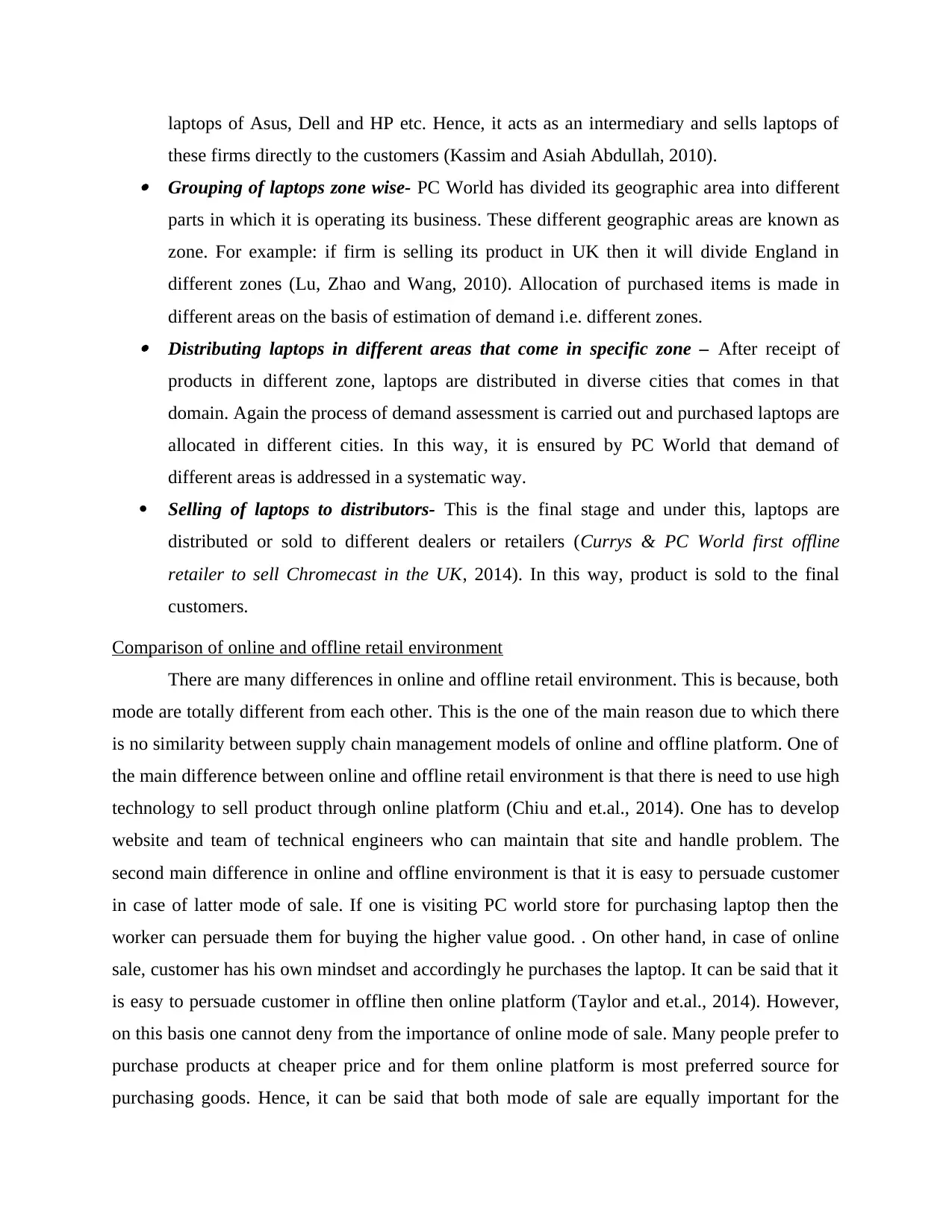
laptops of Asus, Dell and HP etc. Hence, it acts as an intermediary and sells laptops of
these firms directly to the customers (Kassim and Asiah Abdullah, 2010). Grouping of laptops zone wise- PC World has divided its geographic area into different
parts in which it is operating its business. These different geographic areas are known as
zone. For example: if firm is selling its product in UK then it will divide England in
different zones (Lu, Zhao and Wang, 2010). Allocation of purchased items is made in
different areas on the basis of estimation of demand i.e. different zones. Distributing laptops in different areas that come in specific zone – After receipt of
products in different zone, laptops are distributed in diverse cities that comes in that
domain. Again the process of demand assessment is carried out and purchased laptops are
allocated in different cities. In this way, it is ensured by PC World that demand of
different areas is addressed in a systematic way.
Selling of laptops to distributors- This is the final stage and under this, laptops are
distributed or sold to different dealers or retailers (Currys & PC World first offline
retailer to sell Chromecast in the UK, 2014). In this way, product is sold to the final
customers.
Comparison of online and offline retail environment
There are many differences in online and offline retail environment. This is because, both
mode are totally different from each other. This is the one of the main reason due to which there
is no similarity between supply chain management models of online and offline platform. One of
the main difference between online and offline retail environment is that there is need to use high
technology to sell product through online platform (Chiu and et.al., 2014). One has to develop
website and team of technical engineers who can maintain that site and handle problem. The
second main difference in online and offline environment is that it is easy to persuade customer
in case of latter mode of sale. If one is visiting PC world store for purchasing laptop then the
worker can persuade them for buying the higher value good. . On other hand, in case of online
sale, customer has his own mindset and accordingly he purchases the laptop. It can be said that it
is easy to persuade customer in offline then online platform (Taylor and et.al., 2014). However,
on this basis one cannot deny from the importance of online mode of sale. Many people prefer to
purchase products at cheaper price and for them online platform is most preferred source for
purchasing goods. Hence, it can be said that both mode of sale are equally important for the
these firms directly to the customers (Kassim and Asiah Abdullah, 2010). Grouping of laptops zone wise- PC World has divided its geographic area into different
parts in which it is operating its business. These different geographic areas are known as
zone. For example: if firm is selling its product in UK then it will divide England in
different zones (Lu, Zhao and Wang, 2010). Allocation of purchased items is made in
different areas on the basis of estimation of demand i.e. different zones. Distributing laptops in different areas that come in specific zone – After receipt of
products in different zone, laptops are distributed in diverse cities that comes in that
domain. Again the process of demand assessment is carried out and purchased laptops are
allocated in different cities. In this way, it is ensured by PC World that demand of
different areas is addressed in a systematic way.
Selling of laptops to distributors- This is the final stage and under this, laptops are
distributed or sold to different dealers or retailers (Currys & PC World first offline
retailer to sell Chromecast in the UK, 2014). In this way, product is sold to the final
customers.
Comparison of online and offline retail environment
There are many differences in online and offline retail environment. This is because, both
mode are totally different from each other. This is the one of the main reason due to which there
is no similarity between supply chain management models of online and offline platform. One of
the main difference between online and offline retail environment is that there is need to use high
technology to sell product through online platform (Chiu and et.al., 2014). One has to develop
website and team of technical engineers who can maintain that site and handle problem. The
second main difference in online and offline environment is that it is easy to persuade customer
in case of latter mode of sale. If one is visiting PC world store for purchasing laptop then the
worker can persuade them for buying the higher value good. . On other hand, in case of online
sale, customer has his own mindset and accordingly he purchases the laptop. It can be said that it
is easy to persuade customer in offline then online platform (Taylor and et.al., 2014). However,
on this basis one cannot deny from the importance of online mode of sale. Many people prefer to
purchase products at cheaper price and for them online platform is most preferred source for
purchasing goods. Hence, it can be said that both mode of sale are equally important for the
⊘ This is a preview!⊘
Do you want full access?
Subscribe today to unlock all pages.

Trusted by 1+ million students worldwide

specific firm. There is moderate difference in supply chain model of online and offline mode of
distribution. The last and most important difference between online and offline platform is that
real time data can be easily generated by using former mode of sale. This data can be used to
make prediction for next few days or months (Grandón, Nasco and Mykytyn, 2011). So, it can be
said that real time data can be easily collected in case of online than offline platform.
CONCLUSION
On the basis of above discussion it can be concluded that supply chain model in case of
online and offline model is different. Firms must give equal importance in developing supply
chain model online and offline so that company revenue can be increased at the rapid rate.
distribution. The last and most important difference between online and offline platform is that
real time data can be easily generated by using former mode of sale. This data can be used to
make prediction for next few days or months (Grandón, Nasco and Mykytyn, 2011). So, it can be
said that real time data can be easily collected in case of online than offline platform.
CONCLUSION
On the basis of above discussion it can be concluded that supply chain model in case of
online and offline model is different. Firms must give equal importance in developing supply
chain model online and offline so that company revenue can be increased at the rapid rate.
Paraphrase This Document
Need a fresh take? Get an instant paraphrase of this document with our AI Paraphraser
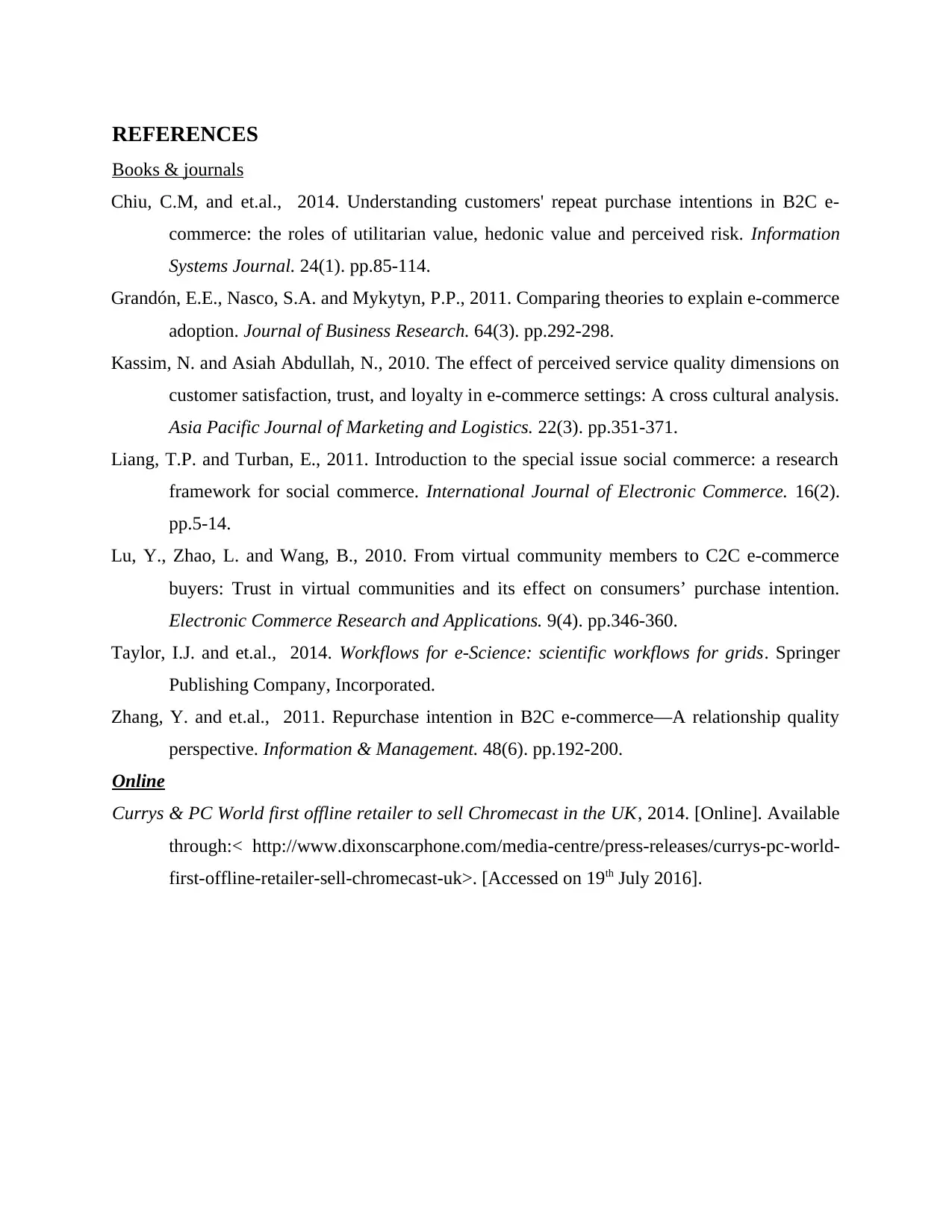
REFERENCES
Books & journals
Chiu, C.M, and et.al., 2014. Understanding customers' repeat purchase intentions in B2C e‐
commerce: the roles of utilitarian value, hedonic value and perceived risk. Information
Systems Journal. 24(1). pp.85-114.
Grandón, E.E., Nasco, S.A. and Mykytyn, P.P., 2011. Comparing theories to explain e-commerce
adoption. Journal of Business Research. 64(3). pp.292-298.
Kassim, N. and Asiah Abdullah, N., 2010. The effect of perceived service quality dimensions on
customer satisfaction, trust, and loyalty in e-commerce settings: A cross cultural analysis.
Asia Pacific Journal of Marketing and Logistics. 22(3). pp.351-371.
Liang, T.P. and Turban, E., 2011. Introduction to the special issue social commerce: a research
framework for social commerce. International Journal of Electronic Commerce. 16(2).
pp.5-14.
Lu, Y., Zhao, L. and Wang, B., 2010. From virtual community members to C2C e-commerce
buyers: Trust in virtual communities and its effect on consumers’ purchase intention.
Electronic Commerce Research and Applications. 9(4). pp.346-360.
Taylor, I.J. and et.al., 2014. Workflows for e-Science: scientific workflows for grids. Springer
Publishing Company, Incorporated.
Zhang, Y. and et.al., 2011. Repurchase intention in B2C e-commerce—A relationship quality
perspective. Information & Management. 48(6). pp.192-200.
Online
Currys & PC World first offline retailer to sell Chromecast in the UK, 2014. [Online]. Available
through:< http://www.dixonscarphone.com/media-centre/press-releases/currys-pc-world-
first-offline-retailer-sell-chromecast-uk>. [Accessed on 19th July 2016].
Books & journals
Chiu, C.M, and et.al., 2014. Understanding customers' repeat purchase intentions in B2C e‐
commerce: the roles of utilitarian value, hedonic value and perceived risk. Information
Systems Journal. 24(1). pp.85-114.
Grandón, E.E., Nasco, S.A. and Mykytyn, P.P., 2011. Comparing theories to explain e-commerce
adoption. Journal of Business Research. 64(3). pp.292-298.
Kassim, N. and Asiah Abdullah, N., 2010. The effect of perceived service quality dimensions on
customer satisfaction, trust, and loyalty in e-commerce settings: A cross cultural analysis.
Asia Pacific Journal of Marketing and Logistics. 22(3). pp.351-371.
Liang, T.P. and Turban, E., 2011. Introduction to the special issue social commerce: a research
framework for social commerce. International Journal of Electronic Commerce. 16(2).
pp.5-14.
Lu, Y., Zhao, L. and Wang, B., 2010. From virtual community members to C2C e-commerce
buyers: Trust in virtual communities and its effect on consumers’ purchase intention.
Electronic Commerce Research and Applications. 9(4). pp.346-360.
Taylor, I.J. and et.al., 2014. Workflows for e-Science: scientific workflows for grids. Springer
Publishing Company, Incorporated.
Zhang, Y. and et.al., 2011. Repurchase intention in B2C e-commerce—A relationship quality
perspective. Information & Management. 48(6). pp.192-200.
Online
Currys & PC World first offline retailer to sell Chromecast in the UK, 2014. [Online]. Available
through:< http://www.dixonscarphone.com/media-centre/press-releases/currys-pc-world-
first-offline-retailer-sell-chromecast-uk>. [Accessed on 19th July 2016].
1 out of 8
Related Documents
Your All-in-One AI-Powered Toolkit for Academic Success.
+13062052269
info@desklib.com
Available 24*7 on WhatsApp / Email
![[object Object]](/_next/static/media/star-bottom.7253800d.svg)
Unlock your academic potential
Copyright © 2020–2025 A2Z Services. All Rights Reserved. Developed and managed by ZUCOL.





